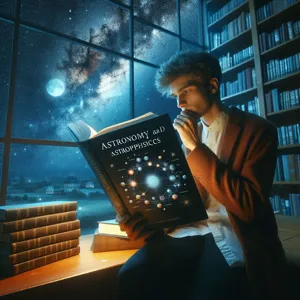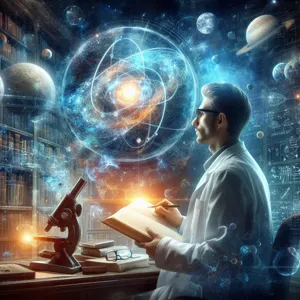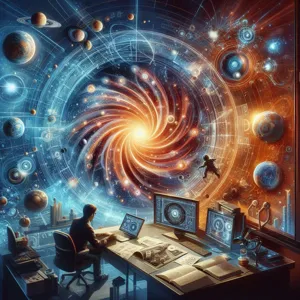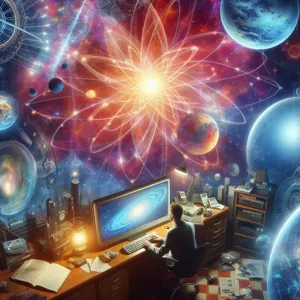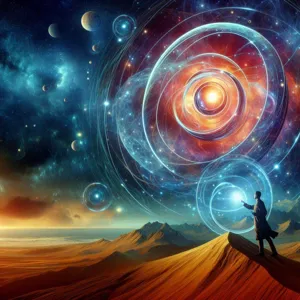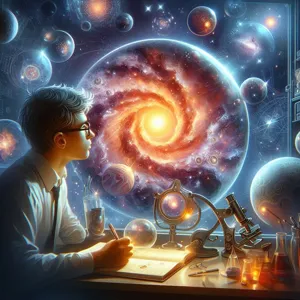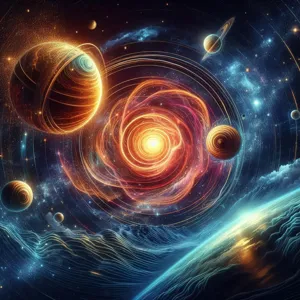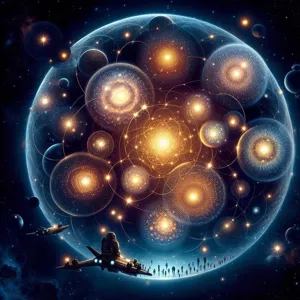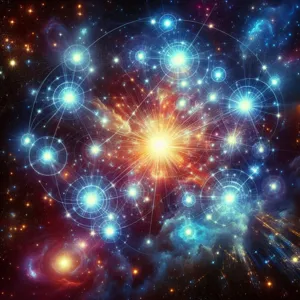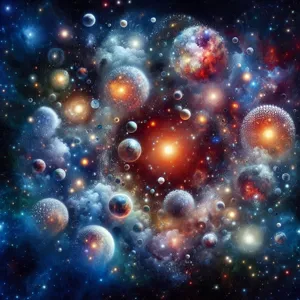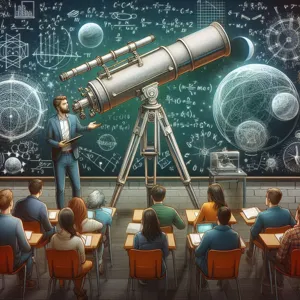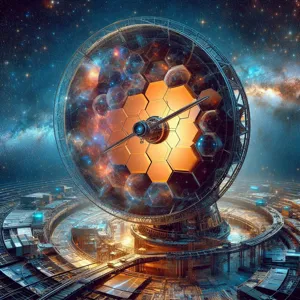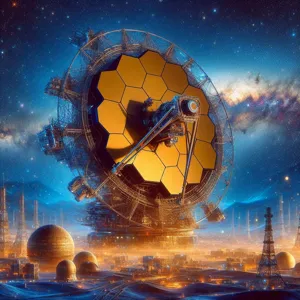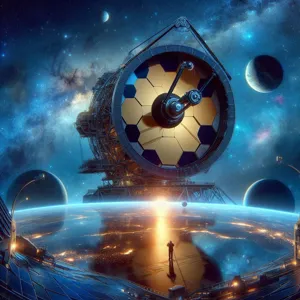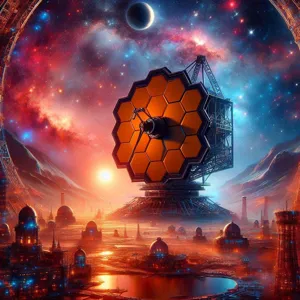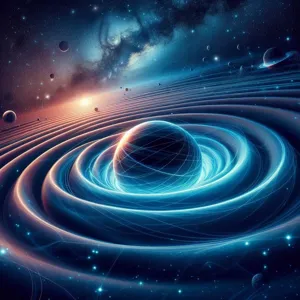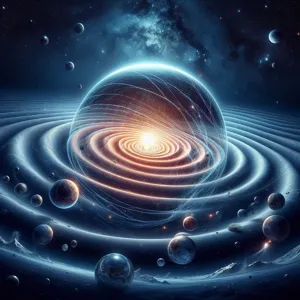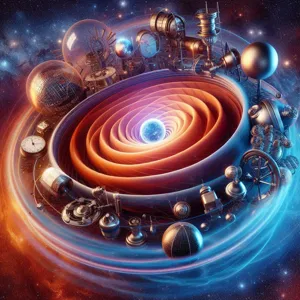The vast expanse of the universe is filled with celestial wonders, and among the most intriguing are binary stars—two stars that orbit a common center of mass, bound together by gravity.
These stellar duos are not just captivating because of their striking beauty, but they also offer a wealth of information about the nature of stars, their life cycles, and the dynamics of our universe. From the mesmerizing dance of light they create in the night sky to the profound implications they hold for our understanding of stellar evolution, binary stars challenge our perceptions and ignite our curiosity. In this blog post, we will embark on an enlightening journey through the cosmos, exploring the unique characteristics of binary star systems, their formation and types, and the role they play in the grand tapestry of the universe. Join us as we uncover the secrets of these celestial companions and the fascinating stories they tell about the cosmos we inhabit.
1. Introduction to Binary Stars
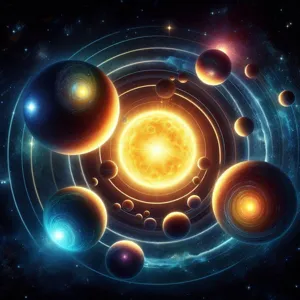
The universe is a vast tapestry of mystery and wonder, and one of its most intriguing threads is the phenomenon of binary stars. Unlike single stars, which shine alone in the cosmos, binary stars exist in pairs, locked in a celestial dance around a common center of mass. This captivating interplay not only serves as a testament to the complex dynamics of our universe but also offers a wealth of information about stellar evolution, formation, and the fundamental properties of matter.
Binary stars are classified into several types, each revealing unique characteristics and behaviors. In visual binaries, the two stars can be individually observed through telescopes, appearing as distinct points of light in the night sky. Spectroscopic binaries, on the other hand, cannot be resolved visually but can be identified through their spectral lines, which shift due to the Doppler effect as the stars orbit one another. Additionally, there are eclipsing binaries, where one star passes in front of the other from our viewpoint, causing periodic dimming that allows astronomers to infer crucial details about their sizes and distances.
These alluring systems are not just an interesting subject of study; they also hold the key to unraveling some of the most profound questions in astrophysics. By observing binary stars, scientists gain insights into the mass, age, and composition of stars, which are vital for understanding the lifecycle of galaxies and the evolution of the universe itself. As we embark on this exploration of binary stars, we will uncover the science behind their formation, the diverse types of binary systems, and the spectacular phenomena that arise from their interactions. Join us on this cosmic journey to discover the beauty and complexity of these stellar companions, and what they can teach us about the nature of the universe.
2. What Are Binary Stars? Definitions and Types
Binary stars are a captivating phenomenon in the universe, representing a pair of stars that are gravitationally bound to each other, orbiting around a common center of mass. This relationship creates a dynamic and intricate dance in the cosmos, where two stellar bodies interact in ways that can reveal much about their individual characteristics and the laws of physics governing them.
There are two primary types of binary stars: **visual binaries** and **spectroscopic binaries**. Visual binaries can be observed directly through telescopes, allowing astronomers to see both stars distinctly as they orbit one another. In contrast, spectroscopic binaries are identified through the Doppler effect; as one star moves toward us, its light shifts to the blue end of the spectrum, while the other moves away, shifting to red. This subtle change in wavelength reveals their orbital motion, even when they are too close together to be seen separately.
Additionally, we can categorize binary stars into a third type known as **eclipsing binaries**. In these systems, the orbital plane of the stars is aligned in such a way that, from our vantage point on Earth, one star passes in front of the other, causing fluctuations in brightness. This not only provides valuable data about the size and mass of the stars involved but also offers a stunning celestial spectacle for observers.
Each type of binary star plays a crucial role in our understanding of stellar evolution, as they can interact in complex ways—such as transferring mass from one star to another, leading to phenomena like novae and even supernovae. By studying these celestial pairs, astronomers unlock secrets about the life cycles of stars, the formation of galaxies, and the very fabric of the universe itself. The world of binary stars is not just a scientific curiosity; it’s a vibrant tapestry woven with mysteries waiting to be explored.
3. Historical Significance of Binary Star Discoveries
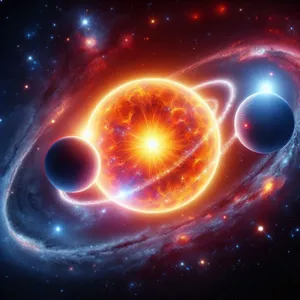
The historical significance of binary star discoveries cannot be overstated, as they have profoundly shaped our understanding of the universe and our place within it. The journey began as far back as the 17th century when astronomers like Giovanni Riccioli and later, Sir William Herschel, first observed pairs of stars that seemed to move together across the night sky. Herschel’s meticulous observations in the late 1700s not only provided the groundwork for the identification of binary systems but also ignited a fascination with the celestial mechanics that govern these stellar duos.
As the 19th century dawned, advancements in telescopic technology allowed astronomers to delve deeper into the mysteries of binary stars. The pioneering work of Alexander von Humboldt and others highlighted how these stellar pairs could be used to calculate the masses of stars, leading to the development of modern astrophysics. The realization that stars could not only orbit each other but also have varying luminosities and temperatures opened up new avenues of inquiry regarding stellar evolution, life cycles, and the fundamental processes that govern the cosmos.
The advent of spectroscopy in the 19th century marked another pivotal moment in binary star research. Astronomers like Edward Pickering utilized spectroscopic techniques to determine the compositions and velocities of stars, revealing that many binaries were not simply visual pairings but rather systems with complex gravitational interactions. This transformative understanding has led to significant breakthroughs, such as the discovery of the concept of mass transfer in close binary systems, which has profound implications for theories of star formation and evolution.
In contemporary astronomy, binary stars serve as essential laboratories for testing theories of stellar physics. They allow scientists to refine models of stellar structure and dynamics and have provided critical insights into phenomena such as supernova explosions and the formation of neutron stars and black holes. Moreover, the study of binary stars has been instrumental in the ongoing quest to understand dark matter and the expansion of the universe, highlighting their enduring significance in the ever-evolving narrative of cosmic exploration.
As we reflect on the historical trajectory of binary star discoveries, we recognize that these celestial companions hold not just scientific value, but also a rich tapestry of storytelling that connects us to the legacy of human curiosity and the quest for knowledge among the stars.
4. How Binary Stars Are Detected
Detecting binary stars is a fascinating endeavor that has evolved significantly with advancements in technology and observational techniques. Astronomers employ a variety of methods to uncover these celestial pairs, each offering unique insights into their characteristics and dynamics.
One of the most common methods is the use of **spectroscopy**, which involves analyzing the light emitted or absorbed by a star. When two stars orbit each other, their gravitational pull causes shifts in their spectral lines due to the Doppler effect. As one star moves towards us, its light is blue-shifted, while the other, moving away, appears red-shifted. By studying these shifts, astronomers can determine not only the presence of a companion star but also its mass and orbital speed.
**Photometric observations** are another key technique for detecting binary stars. This method measures the brightness of a star over time. If a star’s brightness fluctuates periodically, it may indicate the presence of a companion star eclipsing it as they orbit each other. These eclipsing binaries can provide precise measurements of the stars’ sizes and masses, offering a clearer understanding of stellar evolution.
In addition, **direct imaging** has become increasingly viable, particularly with the advent of advanced telescopes and adaptive optics. This technique allows astronomers to capture images of binary systems, revealing the two stars in their magnificent dance across the cosmos. Although challenging due to the overwhelming brightness of a single star, clever techniques like coronagraphy can help isolate the light from a companion star, making it visible to observers.
Lastly, **gravitational microlensing** offers a more exotic method of detection. When a massive object, such as a star, passes in front of a more distant star, it bends the light from the background star due to its gravitational field. If the foreground star has a companion, the lensing effect can reveal the presence of the binary system through subtle variations in brightness.
Together, these methods create a comprehensive toolkit for astronomers, enabling them to unveil the secrets of binary stars hidden within our galaxy. As we continue to refine our techniques and expand our observational capabilities, the mysteries of these cosmic duos become more accessible, enriching our understanding of stellar formation and evolution in the vast expanse of the universe.
5. The Role of Binary Stars in Understanding Stellar Evolution
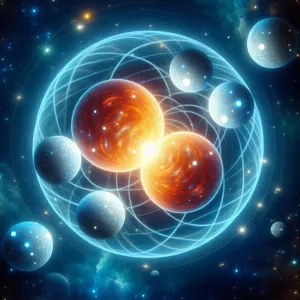
Binary stars, those cosmic pairs bound by gravity, play a crucial role in unraveling the mysteries of stellar evolution. By observing these stellar duo dynamics, astronomers gain invaluable insights into the life cycles of stars, from their birth in nebulae to their eventual demise.
When two stars orbit each other, they interact in ways that single stars simply cannot. For instance, the gravitational pull between the two can lead to mass transfer, where one star siphons material from its partner. This process not only alters the mass and composition of the stars involved but also affects their brightness and temperature. Through studying these interactions, scientists can better understand how stars evolve over time and how they influence one another’s life stages.
Moreover, binary stars serve as natural laboratories for testing theories of stellar formation and evolution. By analyzing the orbital characteristics and luminosity of these systems, astronomers can determine vital parameters such as mass, age, and distance. For instance, eclipsing binaries, where one star passes in front of the other from our vantage point, provide precise measurements of stellar masses and radii. This data helps refine models of how stars age and evolve, revealing the intricate processes that govern their life cycles.
In addition, binary stars are fundamental to our understanding of supernovae. Many of the universe’s most explosive events occur in binary systems, particularly when a white dwarf siphons material from a companion star, leading to a catastrophic explosion. These phenomena not only illuminate the end stages of stellar evolution but also contribute to the chemical enrichment of the universe, seeding the cosmos with heavy elements necessary for planet formation and life as we know it.
In essence, binary stars are key players in the grand narrative of stellar evolution, offering a window into the complex and dynamic processes that shape the life and death of stars across the universe. Their study not only enhances our comprehension of individual stellar systems but also enriches our understanding of the cosmos as a whole, making them an enduring focus of astronomical research.
6. Types of Binary Star Systems (Visual, Spectroscopic, etc.)
When delving into the captivating realm of binary stars, it’s essential to recognize that not all binary systems are created equal. There are several distinct types, each offering unique insights into the nature of these celestial companions.
**Visual Binary Stars** are perhaps the most straightforward to observe. These systems consist of two stars that are sufficiently distant from each other, allowing astronomers to directly see both stars through telescopes. As they orbit around a common center of mass, their changing positions create a mesmerizing dance across the night sky. Observing visual binaries can reveal important information about their sizes, masses, and even compositions, making them a favorite among amateur and professional astronomers alike.
In contrast, **Spectroscopic Binary Stars** present a more challenging yet equally intriguing scenario. These stars are so close together that they cannot be resolved as distinct objects through a telescope. Instead, their binary nature is revealed through the analysis of their light spectra. By studying the Doppler effect—how the wavelengths of light shift as the stars move towards or away from us—astronomers can infer the presence of two stars orbiting each other. This method has provided invaluable data about the masses and velocities of these hidden companions.
There are also **Eclipsing Binary Stars**, which are fascinating in their own right. These systems occur when the orbital plane of the stars is aligned with our line of sight, leading to one star periodically passing in front of the other. This results in a measurable dimming of the light as one star obscures the other. By studying these light curves, astronomers can glean information about the sizes and relative brightness of the stars involved, as well as their orbital dynamics.
Lastly, we have **Astrometric Binaries**, where the presence of a secondary star is inferred through the gravitational influence it exerts on the visible star. Observations reveal that the visible star wobbles slightly in its path due to the gravitational pull of its unseen companion. This subtle movement can provide clues about the mass and distance of the hidden star, offering a glimpse into the complex gravitational interactions that govern these systems.
Each type of binary star system enriches our understanding of the cosmos in different ways, revealing the intricate relationships between stars and the dynamics of their interactions. As we continue to explore these fascinating celestial phenomena, we uncover the secrets of stellar evolution, formation, and the very nature of our universe.
7. The Impact of Binary Stars on Exoplanetary Systems
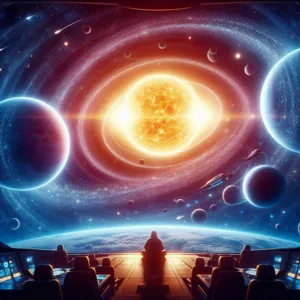
Binary stars, those captivating pairs of celestial bodies bound together by gravity, play a pivotal role in shaping the dynamics of their exoplanetary systems. As we delve deeper into the cosmos, the impact these stellar duos have on the formation, evolution, and stability of planets becomes increasingly evident.
In binary systems, the gravitational tug-of-war between the two stars can significantly influence the orbits of surrounding planets. For instance, the presence of a second star can alter the gravitational landscape, creating a more complex environment for planets to form. This can lead to a diverse array of planetary orbits: some may be stable and circular, while others might be highly elliptical or even subject to gravitational perturbations that could eject them from the system entirely.
Moreover, the distance between the binary stars is a crucial factor. In wide binary systems, planets can maintain stable orbits similar to those found in single-star systems. However, in close binary systems, the intense gravitational forces can create chaotic conditions, posing challenges for the survival of any planets that dare to form in such an environment.
Interestingly, some studies suggest that binary stars may even enhance the likelihood of planet formation. The interaction of the stars can provide the necessary materials and energy for accretion disks, where dust and gas coalesce into planetary bodies. This phenomenon could explain the existence of exoplanets in systems that, at first glance, seem inhospitable due to their binary companions.
As we continue to explore the cosmos, understanding the complexities of binary stars and their influence on exoplanetary systems offers profound insights into the variety of planetary environments that exist in our universe. The interplay of these stellar partners not only enriches our knowledge of how planets emerge and evolve but also expands our search for potentially habitable worlds beyond our solar system. In this grand cosmic ballet, binary stars are not just companions; they are architects of planetary destiny.
8. Famous Binary Star Systems You Should Know About
When delving into the mesmerizing realm of binary stars, several systems stand out not just for their beauty, but also for their significance in the study of astrophysics. Here are a few famous binary star systems that capture the imagination and offer unique insights into the cosmos.
**1. Alpha Centauri:** Perhaps the most well-known binary star system, Alpha Centauri is located just over four light-years from Earth. It consists of three stars: Alpha Centauri A, Alpha Centauri B, and Proxima Centauri. What makes this system particularly fascinating is that Proxima Centauri, a red dwarf star, is the closest known star to our solar system and has at least one confirmed exoplanet, Proxima b, orbiting in its habitable zone.
**2. Sirius:** Often referred to as the “Dog Star,” Sirius is the brightest star in the night sky and is part of a binary system with a companion star, Sirius B. This white dwarf is the remnant of a once massive star that has shed its outer layers and now provides a stunning contrast to the brilliance of its companion. The system is located about 8.6 light-years away and has been a focal point of astronomical study due to its proximity and brightness.
**3. Algol:** Known as the “Demon Star,” Algol is a fascinating example of an eclipsing binary star system. This means that the two stars, Algol A and Algol B, pass in front of each other from our viewpoint on Earth, causing a noticeable variation in brightness. Located in the constellation Perseus, Algol has been observed for centuries and has played a key role in our understanding of stellar evolution and the dynamics of binary systems.
**4. Beta Lyrae:** This binary system is another example of an eclipsing pair, consisting of two massive stars that orbit each other so closely that they share some of their outer atmospheres. Located in the constellation Lyra, Beta Lyrae is a beautiful representation of how binary stars can influence each other’s evolution, making it a subject of ongoing research.
**5. Capella:** A bright star in the constellation Auriga, Capella is actually a binary system composed of two giant stars, Capella A and Capella B, which are themselves binaries, making it a complex system. This system is unique due to its age and the evolutionary stage of its stars, providing astronomers with valuable information about stellar development.
These binary star systems not only enrich our night sky with their charm and brilliance but also serve as key laboratories for understanding the fundamental processes that govern the life cycles of stars. As we continue to explore these celestial wonders, we deepen our appreciation for the cosmic ballet that unfolds above us every night.
9. The Physics of Binary Star Interactions
The physics of binary star interactions is a captivating realm that reveals the complex gravitational dance between two stellar bodies, each exerting its influence on the other. Unlike solitary stars that follow predictable life cycles, binary systems introduce a dynamic interplay that can lead to a variety of extraordinary phenomena.
At the heart of this interaction is gravity, the force that binds these stars together in a captivating orbit. As they circle each other, their masses and distances dictate their gravitational pull, leading to fascinating effects like tidal forces. These forces can distort the shape of the stars, elongating them into an ellipsoidal form and creating significant changes in their atmospheres and surface features.
One of the most intriguing outcomes of binary interactions is mass transfer, which occurs when one star in a binary pair evolves into a red giant and begins to overflow its Roche lobe—an imaginary boundary that defines the region around a star where its gravity dominates. The outer layers of the giant star can spill over to its companion, resulting in the accumulation of material on the second star. This can lead to dramatic changes in both stars: the accreting star may experience an increase in brightness and temperature, while the donor star may shrink and become unstable.
Moreover, binary stars can lead to spectacular events such as novas and supernovae. In some cases, if a white dwarf accumulates enough mass from its companion, it can ignite a thermonuclear explosion, resulting in a nova—a brilliant flash of light that temporarily outshines entire galaxies. In the most extreme scenarios, the merger of two compact objects, like neutron stars, can produce a gravitational wave event, sending ripples through spacetime that can be detected even billions of light-years away.
Understanding the physics of binary star interactions not only enriches our knowledge of stellar evolution but also provides insights into the broader mechanisms governing our universe. The study of these celestial pairings continues to challenge astronomers, offering a glimpse into the intricate relationships that weave the fabric of the cosmos. As we explore the complexities of binary systems, we uncover the secrets of the stars and the fundamental forces that shape their lives, revealing a universe that is as unpredictable as it is beautiful.
10. The Importance of Binary Stars in Cosmology
Binary stars play a pivotal role in our understanding of the cosmos, serving as essential benchmarks for astronomers and cosmologists alike. These celestial pairs, consisting of two stars bound together by gravity, provide unique opportunities to study fundamental astrophysical processes. One of the most significant contributions of binary stars to cosmology is their ability to help determine stellar masses. Through meticulous observations of their orbital motions, scientists can calculate the mass of each star with remarkable precision. This data not only enhances our understanding of stellar evolution but also aids in refining models of how stars form and evolve over time.
Moreover, binary stars are instrumental in the study of distance measurement. The method known as parallax, which involves observing the apparent shift in a star’s position as Earth orbits the Sun, can be significantly improved when binary systems are involved. By analyzing the movements of a binary star system, astronomers can establish a baseline for measuring distances to other celestial objects, enhancing our grasp of the vast scales of the universe.
In addition to their utility in measuring mass and distance, binary stars also serve as laboratories for studying phenomena such as supernovae and gravitational waves. When two stars in a binary system evolve, their interactions can lead to dramatic outcomes—one star may siphon material from the other, eventually resulting in a supernova event. Observing these occurrences provides invaluable insights into the lifecycle of stars and the mechanisms that drive cosmic explosions.
Furthermore, the study of binary stars is crucial for testing theories of gravity and the nature of spacetime. As scientists detect the gravitational waves emitted by merging binary systems, they gain access to a new realm of astrophysical data that challenges our understanding of fundamental physics. Each discovery involving binary stars not only deepens our knowledge of the cosmos but also sparks new questions about the nature of the universe itself.
In summary, binary stars are not just picturesque pairs in the night sky; they are vital to our exploration of the universe. From determining stellar masses and measuring cosmic distances to unraveling the mysteries of gravitational waves, these stellar companions provide a wealth of information that enriches our understanding of the cosmos and our place within it. As we continue to observe and study binary stars, we unlock more secrets of the universe, illuminating the intricate tapestry of celestial phenomena.
11. How Binary Stars Challenge Our Understanding of the Universe
Binary stars, those captivating pairs of stars bound together by gravity, not only enchant amateur astronomers but also pose intriguing challenges to our understanding of the universe. Unlike solitary stars, which follow predictable life cycles largely defined by their mass, binary systems introduce a complex interplay of gravitational forces, interactions, and phenomena that can confound even seasoned astrophysicists.
One of the most striking ways binary stars challenge our understanding is through the phenomenon of mass transfer. In some binaries, one star may be more massive than its partner, evolving more quickly and sometimes reaching the end of its life cycle before the other star even becomes a main-sequence star. When this occurs, the more massive star can begin to siphon material from its companion, leading to dramatic changes in both stars’ evolutionary paths. This mass transfer can result in exotic objects like X-ray binaries, where the accumulating material forms an accretion disk, emitting intense radiation as it spirals inward.
Moreover, the discovery of binary systems has led to new insights about stellar formation and the dynamics of stellar evolution. For instance, the presence of a companion star can influence a primary star’s rotation and chemical composition, ultimately affecting its lifespan and the type of supernova it may produce. As researchers study the light curves and spectroscopic data of binary star systems, they unlock secrets about the universe’s history and the intricate processes that govern star formation.
Additionally, binary stars serve as vital tools for measuring cosmic distances, thanks to the precision of their orbits. By applying Kepler’s laws of motion, astronomers can calculate the mass of stars in a binary system with remarkable accuracy. This information is critical for refining our understanding of stellar populations and the overall structure of galaxies.
As we explore the cosmos, the intricate dance of binary stars not only captivates our imagination but also deepens our comprehension of the universe’s complexities. Each binary system serves as a laboratory for testing theories of stellar evolution and the fundamental laws of physics, reminding us that even in the vastness of space, the simplest pairings can yield the most profound insights.
12. Current Research and Technologies in Binary Star Studies
The study of binary stars has entered an exciting era, fueled by advancements in technology and innovative research methodologies. Today, astronomers are utilizing cutting-edge telescopes and imaging techniques to unlock the secrets of these celestial pairs. One notable advancement is the use of adaptive optics, which corrects the distortion caused by Earth’s atmosphere, allowing for clearer and more detailed observations of binary star systems. This technology enables scientists to measure the masses of stars with unprecedented precision, leading to a better understanding of stellar evolution and dynamics.
In addition to adaptive optics, the advent of space-based observatories, such as the Hubble Space Telescope and the more recent James Webb Space Telescope, has revolutionized binary star research. These instruments provide a unique vantage point, free from atmospheric interference, allowing for deeper observations across various wavelengths. Researchers are now able to explore binaries that were previously hidden from view, including those shrouded in dust or located in distant galaxies.
Moreover, the rise of gravitational wave astronomy has opened up new avenues for studying binary star systems, particularly those that involve compact objects like neutron stars and black holes. By detecting the ripples in spacetime caused by the merger of these celestial bodies, scientists can glean insights into their masses, spins, and the physics governing their interactions. This transformative approach has not only confirmed existing theories but has also posed new questions about the life cycles of stars and the formation of exotic stellar systems.
Researchers are also employing sophisticated computational models to simulate binary star interactions, which help in predicting their behaviors and outcomes over time. These simulations aid in understanding phenomena such as mass transfer, orbital decay, and the eventual fate of binary systems. As our tools and techniques continue to evolve, the field of binary star studies is poised to yield even more groundbreaking discoveries, illuminating the complex tapestry of our universe and the countless stories written in the stars.
13. The Future of Binary Star Exploration
As we stand on the brink of a new era in astrophysics, the future of binary star exploration promises to unlock even more extraordinary secrets of the universe. With advancements in technology and observational capabilities, astronomers are now equipped with tools that allow them to delve deeper into the complexities of these celestial pairings. Ground-based telescopes, such as the upcoming Extremely Large Telescope (ELT), and space observatories like the James Webb Space Telescope (JWST), are set to revolutionize our understanding of binary systems.
The quest to study binary stars goes beyond just understanding their formation and evolution. Researchers are particularly interested in how these stellar duos can reveal insights into the life cycles of stars, including the processes that lead to supernovae or the creation of neutron stars and black holes. Binary stars, especially those in close orbit, present unique opportunities to study gravitational interactions and the effects of mass transfer between stars. These interactions can lead to phenomena such as novae and Type Ia supernovae, which are crucial markers for measuring cosmic distances.
Moreover, the exploration of binary stars is also intertwined with the search for exoplanets. Many binary systems host planets that orbit around one or both stars, and understanding the conditions that allow for planetary formation in these environments could be pivotal in the search for life beyond our solar system. As we refine our observational techniques and enhance our computational models, the prospects of discovering Earth-like planets in binary systems become increasingly tantalizing.
In addition, the upcoming advancements in gravitational wave astronomy are set to cast a new light on binary star systems. The detection of gravitational waves from merging binary black holes or neutron stars opens a unique window into the universe, allowing us to study phenomena that were previously inaccessible to traditional telescopes. As we harness this new field of astrophysics, our understanding of the dynamics and evolutionary pathways of binary systems will deepen, potentially reshaping our comprehension of the cosmos.
In summary, the future of binary star exploration is not just about understanding these fascinating stellar pairs; it is about piecing together the grand puzzle of the universe. As we continue to push the boundaries of our knowledge and technology, the mysteries of binary stars will undoubtedly lead us to groundbreaking discoveries that will expand our understanding of the cosmos and our place within it.
14. Conclusion: The Ongoing Mystery and Beauty of Binary Stars
As we conclude our exploration of binary stars, we are reminded of the profound mysteries that the cosmos continues to unveil. These celestial pairings, where two stars are gravitationally bound to each other, represent a captivating dance of light and gravity. Each binary system tells a unique story, a tale interwoven with the fabric of our universe, revealing insights into stellar evolution, formation processes, and the intricate balance of forces that govern their existence.
The beauty of binary stars lies not only in their visual splendor—often appearing as brilliant companions in the night sky—but also in the complex phenomena they exhibit. From eclipsing binaries that create spectacular light shows to the rare but dramatic events of stellar collisions, these systems challenge our understanding and ignite our curiosity.
As astronomers continue to advance our techniques and technologies, the quest to uncover the secrets of binary stars remains ever compelling. Each new discovery adds another layer to our understanding of the universe, fueling our imagination and sparking new questions. What lies beyond our current knowledge? How do these stellar couples influence the galaxies they inhabit? The enduring allure of binary stars ensures that they will remain a focal point of astronomical research for years to come.
In reflecting on the ongoing mystery and beauty of binary stars, we are reminded of our own place in the cosmos. Just as these stars share an intimate bond, we too are connected to the universe around us, part of a grand narrative that stretches across time and space. As we gaze up at the night sky, let us embrace the wonder of binary stars and the infinite possibilities that lie within the vast expanse of the universe.
15. Resources for Further Exploration of Binary Stars
For those captivated by the mesmerizing realm of binary stars, a wealth of resources awaits to deepen your understanding and appreciation of these celestial wonders. Whether you are a budding astronomer, a casual stargazer, or simply someone with a keen interest in the cosmos, these resources will guide you on your journey of exploration.
**Books**: Start by diving into some highly recommended texts. “Binary Stars: A Comprehensive Study” by Peter J. Kilmartin offers an in-depth exploration of the formation, evolution, and significance of binary star systems. For a more narrative-driven approach, consider “Starlight: A Beginner’s Guide to Binary Stars” by Kevin J. Anderson, which presents complex concepts in an engaging and accessible manner.
**Online Courses**: Websites like Coursera and edX frequently host courses on astronomy and astrophysics, some of which include dedicated modules on binary stars. look for classes taught by renowned institutions like Caltech or MIT, where you can learn from leading experts in the field.
**Podcasts**: Tune into astronomy-focused podcasts such as “StarTalk Radio” or “The Infinite Monkey Cage” where episodes often delve into stellar phenomena, including binary systems. These shows blend education with entertainment, making complex topics approachable for listeners of all backgrounds.
**Websites and Online Communities**: Engage with online platforms like NASA’s official website, which features a dedicated section on binary stars, complete with images, articles, and the latest research updates. Additionally, forums like Astronomy Stack Exchange and Reddit’s r/astrophysics provide vibrant communities where enthusiasts can ask questions, share findings, and discuss recent discoveries.
**Documentaries and Videos**: Visual learners will appreciate documentaries like “The Universe: The Dark Side” or episodes from the acclaimed series “Cosmos,” which often touch upon binary stars and their role in the cosmos. YouTube channels such as PBS Space Time and Fraser Cain’s Universe Today also offer insightful videos that break down the science behind these fascinating systems.
By leveraging these resources, you can embark on an enriching journey through the cosmos, gaining insights into the beauty and complexity of binary stars. Whether through reading, listening, or engaging with communities, the universe of binary stars is rich with knowledge waiting to be uncovered. So grab your telescope, open a book, or tune in to a podcast and prepare to explore the enchanting world that lies beyond our own!
As we conclude our journey through the captivating realm of binary stars, we hope you’ve gained a deeper appreciation for the intricate dance of these stellar duos that illuminate our night sky. From their formation and orbital mechanics to their influence on the evolution of galaxies, binary stars offer a unique glimpse into the dynamic processes at play in our universe. As you gaze up at the stars, remember that many of the points of light you see are part of these remarkable partnerships, each with its own story to tell. Whether you’re a budding astronomer or simply a curious stargazer, we encourage you to continue exploring the cosmos and uncovering the wonders that lie beyond our world. Keep looking up, and who knows what other cosmic secrets you might discover!








